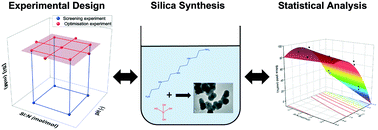Designing bioinspired green nanosilicas using statistical and machine learning approaches†
Abstract
The in vitro bioinspired synthesis of silica, inspired from in vivo biosilicification, is a sustainable alternative to the conventional production of high value porous silicas. The short reaction time, mild reaction conditions of room temperature and its use of benign precursors make this an eco-friendly, economical and scalable route with great industrial potential. However, a systematic optimisation of critical process parameters and material attributes of bioinspired silica is lacking. Specifically, statistical approaches such as design of experiments (DoE) and global sensitivity analysis (GSA) using machine learning could be highly effective but have not been applied to this “green” nanomaterial yet. Herein, for the first time, a sequential DoE strategy was developed with pre-screening experiments to outline the feasible design space. A successive screening using 23 full factorial design determined that from the initially investigated three factors (the ratio of the reactant concentrations, pH, and precursor concentration), only the first two were statistically significant for silica yield and surface area. The subsequent concatenated optimisation using central composite design located a maximum yield of 90 mol% and a maximum surface area of 300–400 m2 g−1. Since for successful commercialisation, high yields and large specific surface areas are desirable, their simultaneous optimisation was also achieved with high predictability regression models. For complementation, a variance-based GSA was successfully applied to bioinspired silica for the first time. This method rapidly identified key parameters and interactions that control the physicochemical properties and provided insights in the wide parameter space, which was validated by the extensive DoE campaign. This work is the starting point in holistically modelling the multidimensional factor–response relationship over a large experimental space in order to complement efforts for resource-efficient product and process development and optimisation of bioinspired silica and beyond.



 Please wait while we load your content...
Please wait while we load your content...